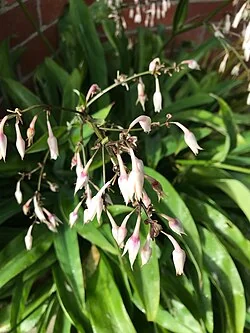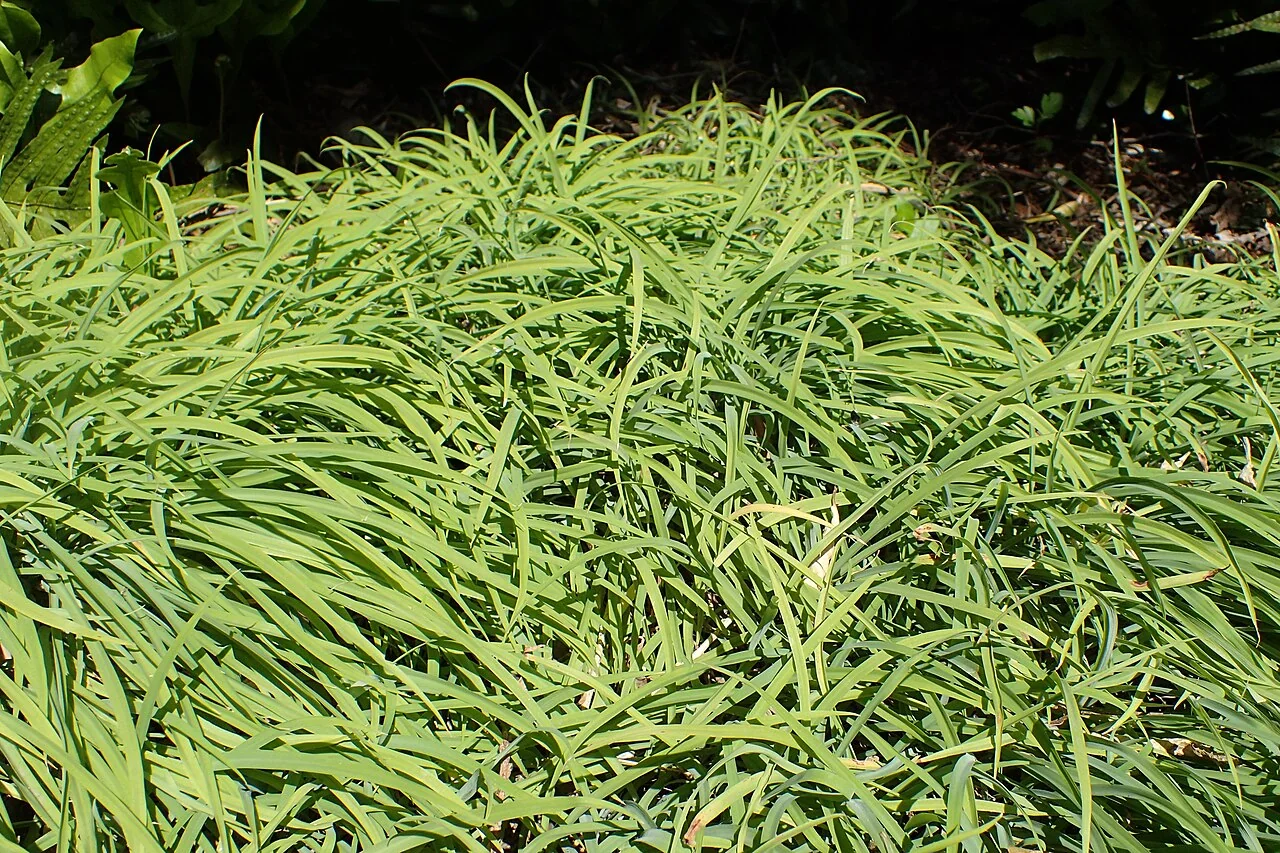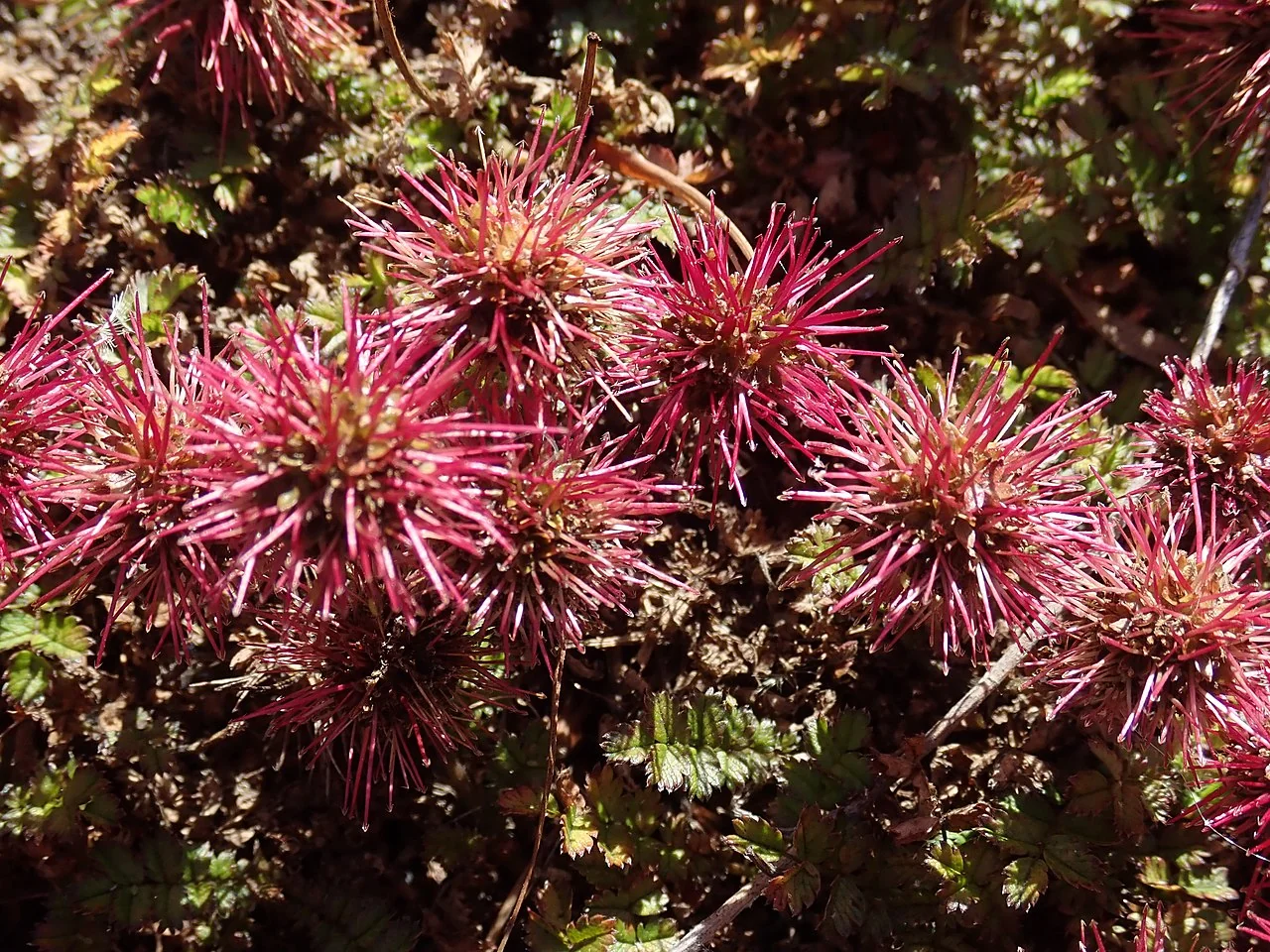
Renga Renga
Arthropodium cirratum
Explore more NZ native plant guides in our index .
Introduction
About Renga Renga Lily
Arthropodium cirratum , commonly known as Renga Renga Lily or Maikāika, is a popular and versatile perennial native to New Zealand. It forms lush clumps of broad, strap-like, emerald-green leaves and produces tall, graceful flower stalks bearing sprays of delicate white, star-shaped flowers in spring and early summer. This hardy plant is widely used in landscaping for its attractive foliage and elegant blooms.

Plant Description
Physical Characteristics
Arthropodium cirratum , commonly known as Renga Renga Lily or Maikāika, is a robust and attractive perennial herb native to New Zealand. It forms dense, evergreen clumps of broad, strap-like leaves that can reach up to 1 meter in length and 10-15 cm in width. The foliage is typically a vibrant emerald green, providing a lush, tropical appearance.
In spring and early summer (from October to December), Renga Renga produces tall, graceful flower stalks that rise well above the foliage, reaching up to 1.5 meters in height. These stalks bear numerous delicate, star-shaped white flowers, often with a subtle yellow or green tinge at the centre. The flowers are arranged in airy sprays, creating a beautiful, cloud-like effect that sways gently in the breeze.
Following the flowering period, small, round, black seed capsules develop, which can be used for propagation. The plant also has thick, fleshy, white rhizomes (underground stems) that store nutrients and water, contributing to its drought tolerance and ease of division. These rhizomes were traditionally consumed by Māori.
Renga Renga is highly valued in horticulture for its architectural form, lush foliage, and elegant flowers, making it a versatile plant for various garden settings.
Quick Facts
Plant Profile
| Scientific Name | Arthropodium Cirratum |
|---|---|
| Height | 0.5-1 m |
| Spread | 0.5-1 m |
| Water Needs | Moderate; prefers consistently moist soil |
| Light | Partial shade to full sun |
| Frost Tolerance | Moderate |
| Salt Tolerance | High |
| Growth Rate | Moderate to fast |
| Lifespan | Perennial |
Climate Best Suited to
Arthropodium cirratum is found in coastal and lowland areas throughout the North Island and the northern South Island of New Zealand. It thrives in a mild, temperate climate and is particularly tolerant of coastal conditions, including salt spray.
Regional Suitability
| Whangārei | Ideal |
| Auckland | Ideal |
| Hamilton | Suitable |
| Rotorua | Suitable |
| Tauranga | Ideal |
| Gisborne | Ideal |
| New Plymouth | Ideal |
| Whanganui | Ideal |
| Palmerston North | Suitable |
| Napier | Ideal |
| Wellington | Ideal |
| Nelson | Ideal |
| Christchurch | Suitable |
| Dunedin | Suitable |
| Invercargill | Suitable |
| City | Climate Suitability |
|---|
Natural Habitat
Native Environment and Distribution
Renga Renga Lily ( Arthropodium cirratum ) is endemic to New Zealand, where it is found naturally in coastal and lowland areas throughout the North Island and the northern parts of the South Island. Its preferred habitats provide insights into its adaptability and resilience.
- Coastal Cliffs and Banks: Renga Renga is particularly well-adapted to coastal environments, often growing on cliffs, rocky outcrops, and banks where it is exposed to salt spray and strong winds. Its thick, fleshy leaves help it to tolerate these harsh conditions.
- Forest Margins and Openings: It can also be found in the margins of lowland forests, in forest clearings, and along stream banks, where it benefits from dappled light and consistent moisture.
- Rocky Areas: The plant thrives in rocky, well-drained soils, often rooting into crevices and cracks where moisture can accumulate.
- Soil Preferences: While adaptable, it prefers well-drained, fertile soils with good organic content. It can tolerate a range of soil types, from sandy coastal soils to heavier loams.
- Associated Flora: In its natural habitat, it often grows alongside other coastal and forest-edge species, forming part of a diverse native plant community.
Its ability to flourish in such varied conditions, from exposed coastal sites to sheltered forest edges, underscores its hardiness and makes it a valuable plant for a wide range of landscaping applications.
Plant Conservation
Threats and Efforts
Renga Renga Lily ( Arthropodium cirratum ) holds a national conservation status of "Not Threatened" in New Zealand, reflecting its widespread presence and adaptability. However, regional conservation statuses can vary, with some areas, like Auckland, classifying it as "At Risk - Regionally Declining." This highlights the importance of local conservation efforts even for nationally secure species.
Conservation efforts for Renga Renga often involve protecting its natural coastal and lowland habitats from development and habitat degradation. Its ease of cultivation and propagation makes it a valuable species for ecological restoration projects, particularly in coastal revegetation, and for promoting biodiversity in home gardens. The plant's historical use and translocation by Māori also underscore its resilience and cultural significance in the landscape. By supporting the protection of its natural environments and encouraging its cultivation, we contribute to the ongoing health and presence of this iconic New Zealand native.
Growing Requirements
Soil Requirements
Prefers well-drained, fertile soil with good organic content. Tolerant of a wide range of soil types, including sandy and clay soils.
Light Requirements
Grows best in partial shade but will tolerate full sun if the soil is kept consistently moist.
Water Requirements
Requires consistent moisture, especially during dry periods. Do not allow the soil to dry out completely.
Planting Guide
-
When to Plant
Plant in autumn or spring.
-
Site Preparation
Choose a partially shaded site with well-drained, fertile soil.
-
Planting and Aftercare
Dig a hole twice the width of the pot. Place the plant in the hole and backfill with soil. Water well and apply a layer of mulch.
Ecological Role
Native Ecosystem Importance
Renga Renga Lily ( Arthropodium cirratum ) plays a significant ecological role within New Zealand's native ecosystems, particularly in coastal and lowland areas. Its presence contributes to biodiversity, soil health, and provides resources for local fauna.
- Soil Stabilization: With its robust, fibrous root system and thick rhizomes, Renga Renga is highly effective at stabilizing soil. This makes it invaluable for erosion control on coastal cliffs, banks, and slopes, helping to prevent soil degradation and maintain landscape integrity.
- Habitat and Shelter: The dense, evergreen clumps of Renga Renga provide crucial shelter and microhabitats for a variety of native invertebrates, insects, and small ground-dwelling birds. These creatures find refuge from predators and harsh weather conditions within its protective foliage.
- Food Source: While not a primary food source for large native herbivores, the flowers attract native insects, and the seeds may be consumed by small birds, contributing to the local food web. The edible rhizomes also represent a historical food source for Māori.
- Pioneer Species: In some disturbed or open environments, particularly in coastal areas, Renga Renga can act as a pioneer species. It helps to colonize bare ground, improve soil structure, and provide initial cover, facilitating the establishment of other native plant species.
- Biodiversity Contribution: As an indigenous plant, it contributes to the overall biodiversity of New Zealand's coastal and lowland ecosystems. Maintaining diverse native plant communities is essential for ecosystem resilience and health.
The ecological contributions of Renga Renga underscore its importance in supporting the health and balance of its native habitats, making it a key species in restoration efforts and natural landscapes.
Uses and Significance
Garden Uses
- An excellent plant for mass planting, borders, containers, and shady areas.
- It is also a good choice for coastal gardens due to its salt tolerance.
Cultural Significance
Traditional Uses and Values
Renga Renga Lily ( Arthropodium cirratum ) holds significant cultural value for Māori. The rhizomes were a traditional food source, and the plant was also used for medicinal purposes. Its presence in coastal areas made it a readily available resource.
Landscaping Applications
Design and Application
Renga Renga Lily ( Arthropodium cirratum ) is a highly valued and versatile plant in landscape design, celebrated for its lush foliage, elegant flowers, and adaptability to various conditions. It is an excellent choice for adding a touch of native New Zealand beauty to a wide range of garden styles.
- Mass Planting: Ideal for mass planting as groundcover on banks, slopes, or under trees, where its dense foliage helps suppress weeds and its collective blooms create a stunning visual display. It is particularly effective in large areas where a uniform, lush look is desired.
- Borders and Edging: Its neat, clumping habit and attractive foliage make it perfect for defining borders along pathways, driveways, or garden beds. It provides a soft yet structured edge.
- Container Planting: Renga Renga thrives in pots and containers, making it suitable for patios, balconies, and courtyards. Its cascading leaves and tall flower stalks create an elegant focal point.
- Coastal Gardens: Due to its high salt tolerance and ability to withstand wind, it is an excellent choice for coastal gardens, where it can provide greenery and colour in challenging conditions.
- Shade Gardens: While it tolerates full sun if kept moist, Renga Renga excels in partial to full shade, brightening darker areas with its vibrant green foliage and white flowers. It pairs well with ferns and other shade-loving native plants.
- Underplanting: Use it as an effective underplanting for taller native trees and shrubs, providing a lush base and enhancing the overall native garden aesthetic.
When incorporating Renga Renga into your landscape, consider its mature size and spread to ensure it has ample space to flourish. Its low maintenance requirements and year-round appeal make it a favorite among gardeners.
Seasonal Care Calendar
Spring
- Apply a balanced fertilizer and a layer of mulch.
Summer
- Water regularly, especially during dry periods.
Autumn
- No special care required.
Winter
- Protect from heavy frosts in colder regions.
Pruning and Maintenance
Simple Care
Remove spent flower stalks to encourage new blooms and maintain a tidy appearance. Old or damaged leaves can be removed as needed.
How to Grow Renga Renga
Division
Division is the most reliable and efficient method for propagating Renga Renga, particularly for maintaining specific cultivars and achieving rapid multiplication of desired forms. This clump-forming perennial naturally develops thick, fleshy rhizomes that can be easily separated to create new plants identical to the parent. The optimal timing for division is during the plant's dormant period in late autumn to early spring, when the foliage is reduced and the rhizome system is most accessible. Begin by carefully lifting the entire clump using a garden fork, working around the perimeter to avoid damaging the substantial root system. Once lifted, gently shake or wash away excess soil to reveal the network of thick, pale rhizomes that form the plant's underground storage system. Each division should include both healthy rhizome material and visible growing points or shoots. Use a sharp, clean knife to cut through connecting tissues if necessary, ensuring each section has adequate root material for establishment. Some cultivars, particularly 'Downtown' and other garden selections, can be divided more readily and multiply more rapidly than the typical species, making them especially valuable for large-scale plantings. Replant divisions immediately at the same depth they were previously growing, spacing them 40-60cm apart to accommodate their mature spread. Water thoroughly after planting and maintain consistent moisture during the establishment period. New growth typically appears within 4-8 weeks during favorable conditions, and divisions often flower in their first season. This method is particularly valuable for preserving specific cultivar characteristics and quickly building up stock for landscaping projects or coastal plantings where Renga Renga's salt tolerance is highly valued.
Seeds
Seed propagation of Renga Renga offers excellent results with proper timing and technique, though it requires more patience than division and may produce some variation in plant characteristics. The plant produces abundant seeds following its spectacular white flower displays, typically ripening in late summer to autumn. Fresh seeds provide the best germination rates, so collect them as soon as the seed pods begin to split and the seeds have turned dark brown or black. Process seeds by cleaning away any remaining fruit material and sow immediately for optimal results. Use a quality seed-raising mix in shallow trays or individual cells, ensuring excellent drainage while maintaining consistent moisture. Sow seeds at a depth of approximately 2-3mm, as they require some darkness for germination but should not be buried too deeply. Place containers in a warm position with bright, indirect light and maintain temperatures around 18-22°C for optimal germination. Under suitable conditions, germination typically begins within 10 days to 2 weeks, though some seeds may take up to a month to emerge. The initial germination rate is usually very high, often exceeding 80% with fresh seed. Seedlings develop slowly initially, forming small tufts of narrow leaves before developing their characteristic thick rhizomes. Transplant seedlings when they reach 3-5cm in height into individual pots using a well-draining potting mix, and grow them on for at least one full growing season before planting out. Seed-grown plants typically take 2-3 years to reach flowering size and may show natural variation in leaf width, flower size, and overall plant vigor. This variation can be valuable for restoration projects where genetic diversity is desired, though division is preferred when specific cultivar characteristics must be maintained.
Rhizome Cuttings
Rhizome cutting propagation takes advantage of Renga Renga's substantial underground storage system, offering an alternative method for multiplication when complete division is not practical or desired. This technique is particularly useful when only small amounts of plant material are available or when trying to maximize the number of new plants from a single specimen. The thick, fleshy rhizomes that characterize this species contain abundant stored energy and growing points that can develop into new plants under suitable conditions. During the dormant season, carefully excavate portions of the rhizome system without disturbing the main plant, selecting healthy, firm sections that show visible nodes or growing points. Cut rhizome pieces approximately 5-8cm in length using a sharp, sterile knife, ensuring each piece contains at least one viable growing point. Allow cut surfaces to dry and callus for 24-48 hours in a warm, dry location to prevent rot when planted. Plant rhizome cuttings horizontally in well-draining propagation mix, covering them with approximately 2-3cm of growing medium. Maintain consistent moisture without waterlogging and provide bright, indirect light with protection from temperature extremes. Root and shoot development typically occurs within 4-8 weeks, though some cuttings may take longer to establish depending on environmental conditions and rhizome quality. This method requires more skill and attention than simple division but can be valuable when propagating valuable cultivars or when plant material is limited. The thick rhizomes not only serve as propagation material but also represent the edible portion traditionally harvested by Māori, containing starches that become sweet and nutritious when cooked. Success rates with rhizome cuttings are generally good with proper technique, making this an effective method for experienced propagators seeking to maximize plant numbers from limited stock material.
Pests and Diseases
Common Issues
While generally hardy, renga lily can suffer from bacterial leaf spot causing brown markings on foliage, and mollusc damage from slugs and snails particularly affecting young growth. Apply organic slug bait around young plants and ensure good air circulation to prevent bacterial issues. Most cultivars show good resistance, with some varieties more susceptible than others to these problems.
Bonus Tip
Culinary Use of Rhizomes
A unique aspect of Renga Renga Lily ( Arthropodium cirratum ) is the edibility of its rhizomes. Traditionally, Māori harvested and cooked these thick, fleshy underground stems as a food source. The rhizomes are starchy and, when cooked, become sweet and nutritious.
If you're interested in exploring this traditional use, ensure that any plants you intend to harvest are positively identified as Arthropodium cirratum and have been grown in a pesticide-free environment. The rhizomes can be dug up, cleaned thoroughly, and then roasted, boiled, or steamed. This offers a fascinating way to connect with the plant's cultural history and New Zealand's native food traditions.







